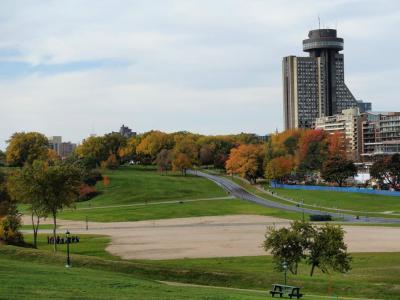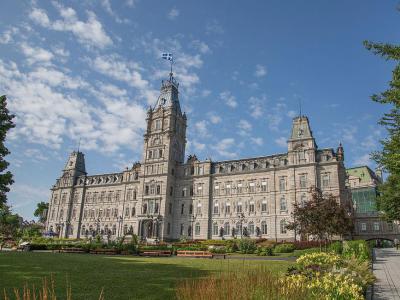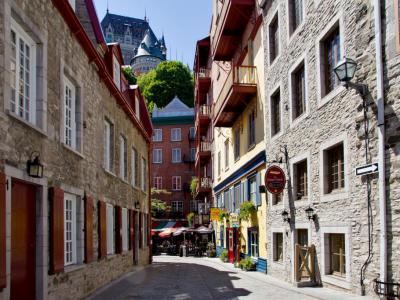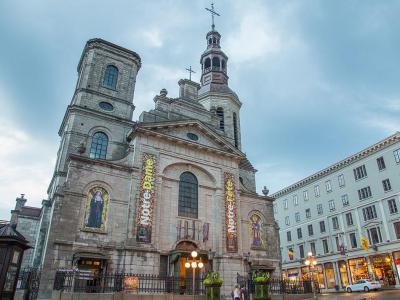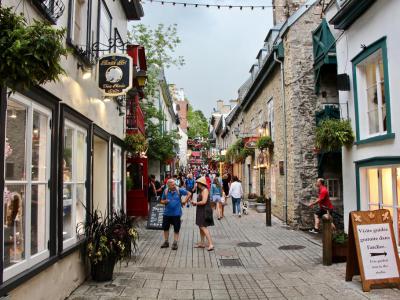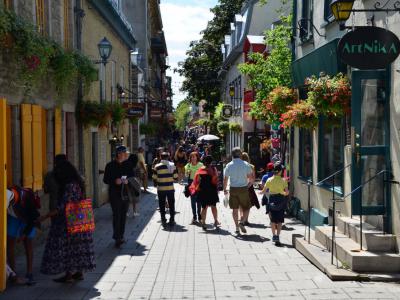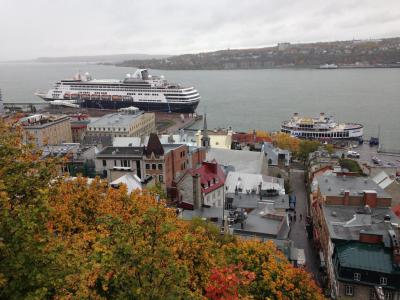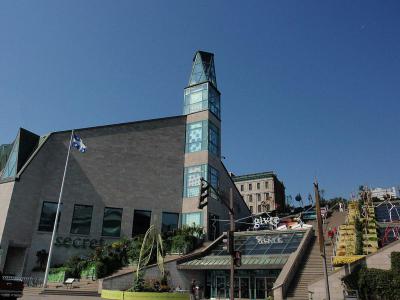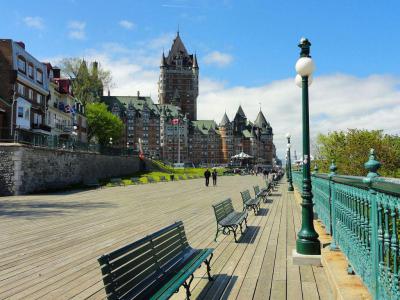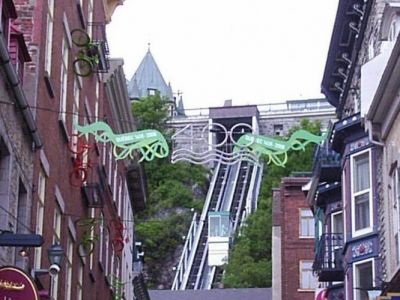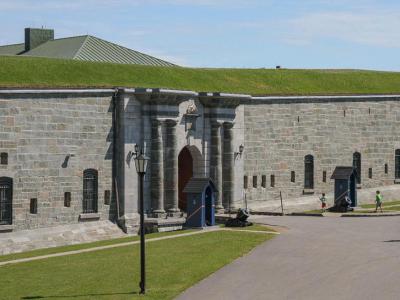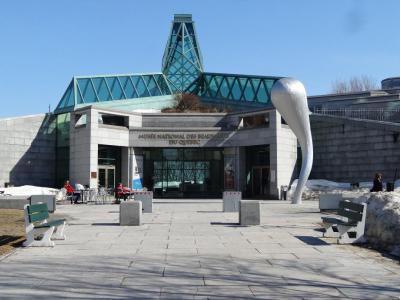Custom Walk in Quebec City, Quebec by medinae218_e6b55 created on 2025-01-09
Guide Location: Canada » Quebec City
Guide Type: Custom Walk
# of Sights: 15
Tour Duration: 3 Hour(s)
Travel Distance: 6.3 Km or 3.9 Miles
Share Key: SKBF3
Guide Type: Custom Walk
# of Sights: 15
Tour Duration: 3 Hour(s)
Travel Distance: 6.3 Km or 3.9 Miles
Share Key: SKBF3
How It Works
Please retrieve this walk in the GPSmyCity app. Once done, the app will guide you from one tour stop to the next as if you had a personal tour guide. If you created the walk on this website or come to the page via a link, please follow the instructions below to retrieve the walk in the app.
Retrieve This Walk in App
Step 1. Download the app "GPSmyCity: Walks in 1K+ Cities" on Apple App Store or Google Play Store.
Step 2. In the GPSmyCity app, download(or launch) the guide "Quebec City Map and Walking Tours".
Step 3. Tap the menu button located at upper right corner of the "Walks" screen and select "Retrieve custom walk". Enter the share key: SKBF3
1) Plains of Abraham / Battlefield Park (must see)
On the Plains of Abraham on September 13, 1759, the French fell to the British, forever changing the course of North American history. After Champlain's arrival in 1608, there were skirmishes on and off with the British, who at the time were fighting for control of the North American colonies against the French, but it wasn’t until 1759 that the real battle took place. It was all over in 15 minutes, and five days later, Québec capitulated.
The peculiar name Plains of Abraham can be traced as far back as 1635, when Abraham Martin, a pilot of the Saint Lawrence and a friend of Samuel de Champlain, was given 12 acres of land in the area. Today there is little trace of the battle on the rolling green hills of the plains that border the cliff above the river. The grandiose stone building set back from the Plains houses the park's museum and interpretation center, which offers a multimedia exhibit of its history, from the battle to its popularity with prostitutes in the 19th century and as a choice spot for duels, hangings, and the Stanley Cup playoffs. The park itself was part of the 300th anniversary celebrations and was designed by Frederick Todd. Many of the cannons that line the park were gifts from other nations to remind people that this was once a battlefield.
If you're interested in doing more than just strolling and picnicking in the park, you can head to the Plains of Abraham Museum, where you can visit the Battles 1759-1760 exhibit, which features first-hand soldiers' accounts, battle paraphernalia, and immersive video.
Why You Should Visit:
The park is expansive and very well maintained. You can walk yourself around the battlefields without taking a guided tour as explanatory signs are everywhere.
There are all sorts of activities during the summer and holidays, as well as many quiet areas to just relax and enjoy the solitude of the area.
The museum offers a variety of exhibits and a short film about the famous battle – all worth seeing.
Tip:
Combine your visit with the Joan of Arc Garden and the Citadelle, and make sure to explore all the streets and shops nearby.
The peculiar name Plains of Abraham can be traced as far back as 1635, when Abraham Martin, a pilot of the Saint Lawrence and a friend of Samuel de Champlain, was given 12 acres of land in the area. Today there is little trace of the battle on the rolling green hills of the plains that border the cliff above the river. The grandiose stone building set back from the Plains houses the park's museum and interpretation center, which offers a multimedia exhibit of its history, from the battle to its popularity with prostitutes in the 19th century and as a choice spot for duels, hangings, and the Stanley Cup playoffs. The park itself was part of the 300th anniversary celebrations and was designed by Frederick Todd. Many of the cannons that line the park were gifts from other nations to remind people that this was once a battlefield.
If you're interested in doing more than just strolling and picnicking in the park, you can head to the Plains of Abraham Museum, where you can visit the Battles 1759-1760 exhibit, which features first-hand soldiers' accounts, battle paraphernalia, and immersive video.
Why You Should Visit:
The park is expansive and very well maintained. You can walk yourself around the battlefields without taking a guided tour as explanatory signs are everywhere.
There are all sorts of activities during the summer and holidays, as well as many quiet areas to just relax and enjoy the solitude of the area.
The museum offers a variety of exhibits and a short film about the famous battle – all worth seeing.
Tip:
Combine your visit with the Joan of Arc Garden and the Citadelle, and make sure to explore all the streets and shops nearby.
2) Parliament Building (Hotel du Parlement) (must see)
The Parliament Building, house of the National Assembly of Québec, is one of the most impressive buildings in the province's capital city. Located on one of the highest spots of Upper Town, just outside the city walls, the quadrilateral building was constructed between 1877-86 by the French architect Eugène-Étienne Taché. Inspired by the Louvre in Paris, the style of building, Second Empire neo-French Renaissance, is unique in North America. The front of the building also features a pantheon representing the province’s rich history.
Incensed by the Durham Report, in which the British lord said that the French-Canadians could not be civilized because they had no history, Taché included 15 statues depicting important figures in the province's history, to show that they did indeed have a strong past. Figures include Samuel de Champlain, Louis de Buade de Frontenac, James Wolfe, the Marquis de Montcalm, and, at the very top, an indigenous family. As the province's political life continues to grow, so does the number of statues; there are 26 statues featured on the building's facade and more scattered across the grounds.
Since it is still a functioning government office, the only way to see the interior of the building is to take a free guided tour. At 45 minutes long, the tour provides a great opportunity to appreciate the unique architecture of the building, as well as gain insight into Québec's history and political scene. Make sure to have a photo ID with you, however; otherwise you won't pass the security check. In the summer, outdoor tours are also given to discover the surrounding gardens, which highlight the many trees and flowers of Québec and also give an overview of the many sculptures. All tours leave from the visitors center.
Why You Should Visit:
The building is just bursting with history. The architecture, paintings and stained glass windows are simply breathtaking.
The free tour (English/French) is conducted very well, giving one a good understanding of how the government operates.
The restaurant is outstanding and honors Quebec cuisine, with many of the ingredients being grown in the Parliament’s garden. Good prices, too!
Tip:
Note that you must have reservations to eat at the restaurant serving the Provincial Assembly when in session.
Incensed by the Durham Report, in which the British lord said that the French-Canadians could not be civilized because they had no history, Taché included 15 statues depicting important figures in the province's history, to show that they did indeed have a strong past. Figures include Samuel de Champlain, Louis de Buade de Frontenac, James Wolfe, the Marquis de Montcalm, and, at the very top, an indigenous family. As the province's political life continues to grow, so does the number of statues; there are 26 statues featured on the building's facade and more scattered across the grounds.
Since it is still a functioning government office, the only way to see the interior of the building is to take a free guided tour. At 45 minutes long, the tour provides a great opportunity to appreciate the unique architecture of the building, as well as gain insight into Québec's history and political scene. Make sure to have a photo ID with you, however; otherwise you won't pass the security check. In the summer, outdoor tours are also given to discover the surrounding gardens, which highlight the many trees and flowers of Québec and also give an overview of the many sculptures. All tours leave from the visitors center.
Why You Should Visit:
The building is just bursting with history. The architecture, paintings and stained glass windows are simply breathtaking.
The free tour (English/French) is conducted very well, giving one a good understanding of how the government operates.
The restaurant is outstanding and honors Quebec cuisine, with many of the ingredients being grown in the Parliament’s garden. Good prices, too!
Tip:
Note that you must have reservations to eat at the restaurant serving the Provincial Assembly when in session.
3) Morrin Centre (must see)
One of the most famous cultural landmarks in Quebec City, the Morrin Centre is dedicated to educating the public about the history of English-speaking Quebec and showcasing the present-day culture of local English speakers.
Here you will find the private English-language library of the Literary and Historical Society of Quebec, located on the premises since 1868, and comprising over 20,000 books, a small collection of archives, manuscripts, films and videos, electronic records, nearly 800 artifacts, plus the Stephens collection of decorative items and tea-ware related to the English families of Quebec City.
The centre is found in a former prison building – Quebec City Common Gaol – which operated from 1814 to 1861. The property was sold to Doctor Joseph Morrin in 1868, who turned it into a college for young English speakers, designed by architect Joseph-Ferdinand Peachy, which served in this capacity until 1902. The heritage building was designated a National Historic Site of Canada in 1981.
Visitors to the Morrin Centre can take a guided tour of the building (in either English or French) during which they can see the dark dank cells where prisoners spent their sentences for crimes ranging from drunkenness to murder to stealing tea! There is also an original darkroom that may be the world's oldest in existence.
Any place that can boast of having been a prison, a college, and a library, is well worth visiting and guarantees time well spent. Here, apart from jails, you can learn a little bit more about Quebec history, too.
Here you will find the private English-language library of the Literary and Historical Society of Quebec, located on the premises since 1868, and comprising over 20,000 books, a small collection of archives, manuscripts, films and videos, electronic records, nearly 800 artifacts, plus the Stephens collection of decorative items and tea-ware related to the English families of Quebec City.
The centre is found in a former prison building – Quebec City Common Gaol – which operated from 1814 to 1861. The property was sold to Doctor Joseph Morrin in 1868, who turned it into a college for young English speakers, designed by architect Joseph-Ferdinand Peachy, which served in this capacity until 1902. The heritage building was designated a National Historic Site of Canada in 1981.
Visitors to the Morrin Centre can take a guided tour of the building (in either English or French) during which they can see the dark dank cells where prisoners spent their sentences for crimes ranging from drunkenness to murder to stealing tea! There is also an original darkroom that may be the world's oldest in existence.
Any place that can boast of having been a prison, a college, and a library, is well worth visiting and guarantees time well spent. Here, apart from jails, you can learn a little bit more about Quebec history, too.
4) Old Quebec (must see)
Old Québec is a historically significant neighborhood within Quebec City, encompassing both the Upper Town and Lower Town areas. This locale holds the prestigious designation of being a UNESCO World Heritage Site. From an administrative perspective, Old Quebec is situated within the Vieux-Québec–Cap-Blanc–colline Parlementaire district, which falls under the jurisdiction of the La Cité-Limoilou borough. In English, it is commonly referred to as "the Old City" or "Québec's Old City."
The majority of the buildings in the Upper Town section of Old Québec originate from the 19th century, with a few dating back to the 17th and 18th centuries. This area boasts several commercial streets, such as Saint Jean, Sainte Anne, and De Buade, with numerous hotels, including the renowned Château Frontenac, making it a highly sought-after tourist destination. In the Upper Town, you can find parks like De l'Esplanade, Artillerie, Des Gouverneurs, Montmorency, and the grounds of l’Hotel-de-Ville.
The Lower Town, situated at the base of Cap Diamant, holds historical significance. The construction of the Church of Notre-Dame-des-Victoires commenced in 1687 at this location and was completed in 1723. Lower Town features notable cultural institutions such as the Musée de la civilisation, the Musée naval de Québec, the caserne Dalhousie, and the Théâtre Petit Champlain, which encompass museums, performance venues, theaters, and exhibition spaces.
The majority of the buildings in the Upper Town section of Old Québec originate from the 19th century, with a few dating back to the 17th and 18th centuries. This area boasts several commercial streets, such as Saint Jean, Sainte Anne, and De Buade, with numerous hotels, including the renowned Château Frontenac, making it a highly sought-after tourist destination. In the Upper Town, you can find parks like De l'Esplanade, Artillerie, Des Gouverneurs, Montmorency, and the grounds of l’Hotel-de-Ville.
The Lower Town, situated at the base of Cap Diamant, holds historical significance. The construction of the Church of Notre-Dame-des-Victoires commenced in 1687 at this location and was completed in 1723. Lower Town features notable cultural institutions such as the Musée de la civilisation, the Musée naval de Québec, the caserne Dalhousie, and the Théâtre Petit Champlain, which encompass museums, performance venues, theaters, and exhibition spaces.
5) Notre-Dame de Québec (must see)
The Cathedral-Basilica of Our Lady of Quebec City (Notre-Dame de Québec) is the oldest church in Canada. It sits on the site of the former chapel of Our Lady of Recovery (Notre Dame de la Recouvrance), which was built by Samuel de Champlain in 1633.
This is also the first church in Canada to be ranked as a minor basilica – by Pope Pius IX, in 1874.
Over the years, the cathedral has been destroyed twice by fires: the first time during the Siege of Quebec, in 1759; and then in 1922, gutted by arson by the members of the Canadian faction of the Ku Klux Klan.
The church was designated a National Historic Site of Canada in 1989. Inside, you will find a chancel lamp donated by Louis XIV and impressive adornments such as stained glass windows, paintings of the Virgin Mary dating back to the French colonial regime, the old bishop's throne, and a stunning gold-plated baldaquin canopy suspended above the altar.
From 1654 to 1898, some 900 people were buried in the church crypt; among them four governors of New France and twenty bishops of Quebec, including François de Laval, Quebec's first bishop. It is also rumored that Samuel de Champlain himself is buried somewhere nearby; archaeologists have been searching for his grave for decades.
In 2014, when the cathedral celebrated its 350th anniversary, a holy door – a special entrance portal traditionally located within the Papal major basilicas in Rome – was installed here, being the only one of its kind in North America and one of eight across the entire world.
Tip:
See the basilica during the day, but consider the laser light show in the evening. The line to get in is very long, so buy your tickets online and pick them up at the office the night of the performance. Not the cheapest 30 minutes, but well worth it if you want to see the magnificent building shine in a whole new way.
Entry is free for self-guided visits; it is also possible to visit the crypt on a guided tour, for a charge.
This is also the first church in Canada to be ranked as a minor basilica – by Pope Pius IX, in 1874.
Over the years, the cathedral has been destroyed twice by fires: the first time during the Siege of Quebec, in 1759; and then in 1922, gutted by arson by the members of the Canadian faction of the Ku Klux Klan.
The church was designated a National Historic Site of Canada in 1989. Inside, you will find a chancel lamp donated by Louis XIV and impressive adornments such as stained glass windows, paintings of the Virgin Mary dating back to the French colonial regime, the old bishop's throne, and a stunning gold-plated baldaquin canopy suspended above the altar.
From 1654 to 1898, some 900 people were buried in the church crypt; among them four governors of New France and twenty bishops of Quebec, including François de Laval, Quebec's first bishop. It is also rumored that Samuel de Champlain himself is buried somewhere nearby; archaeologists have been searching for his grave for decades.
In 2014, when the cathedral celebrated its 350th anniversary, a holy door – a special entrance portal traditionally located within the Papal major basilicas in Rome – was installed here, being the only one of its kind in North America and one of eight across the entire world.
Tip:
See the basilica during the day, but consider the laser light show in the evening. The line to get in is very long, so buy your tickets online and pick them up at the office the night of the performance. Not the cheapest 30 minutes, but well worth it if you want to see the magnificent building shine in a whole new way.
Entry is free for self-guided visits; it is also possible to visit the crypt on a guided tour, for a charge.
6) Petit-Champlain Street (Rue du Petit-Champlain) (must see)
A charming narrow street at the base of Cape Diamond, known as Rue du Petit-Champlain, serves as the heart of the quaint neighborhood sharing its name. This area pays homage to Samuel de Champlain, the French explorer credited with founding Quebec City back in 1608.
Stretching a mere 814 feet (or 260 meters) in length, Petit-Champlain, translating to "Little Champlain," should not be confused with Champlain Street further to the west, located in the Cap-Blanc district. These two streets were once connected until a rockslide in 1889 separated them.
Towards the southern terminus of Petit-Champlain, you'll come across a sizable trompe-l'œil mural adorning the side of a three-story building at No. 102. This mural vividly recounts the neighborhood's history, encompassing significant events such as the 1759 bombardments, landslides, and numerous fires that have plagued the area over the years.
At the opposite end of the street lies the renowned Breakneck Staircase, aptly named for its steepness, offering a picturesque view of the surrounding area.
Just beyond the staircase awaits the lower entrance to the Old Quebec Funicular, known as the Funiculaire du Vieux-Québec. Operating since 1879, this electric cableway navigates Cape Diamond at a sharp 45-degree angle, covering a total distance of 64 meters (210 feet).
In 2014, Petit-Champlain received recognition as "the most remarkable street" in Canada, a title bestowed upon it through public and professional polls conducted during an event organized by the Canadian Institute of Planners.
Stretching a mere 814 feet (or 260 meters) in length, Petit-Champlain, translating to "Little Champlain," should not be confused with Champlain Street further to the west, located in the Cap-Blanc district. These two streets were once connected until a rockslide in 1889 separated them.
Towards the southern terminus of Petit-Champlain, you'll come across a sizable trompe-l'œil mural adorning the side of a three-story building at No. 102. This mural vividly recounts the neighborhood's history, encompassing significant events such as the 1759 bombardments, landslides, and numerous fires that have plagued the area over the years.
At the opposite end of the street lies the renowned Breakneck Staircase, aptly named for its steepness, offering a picturesque view of the surrounding area.
Just beyond the staircase awaits the lower entrance to the Old Quebec Funicular, known as the Funiculaire du Vieux-Québec. Operating since 1879, this electric cableway navigates Cape Diamond at a sharp 45-degree angle, covering a total distance of 64 meters (210 feet).
In 2014, Petit-Champlain received recognition as "the most remarkable street" in Canada, a title bestowed upon it through public and professional polls conducted during an event organized by the Canadian Institute of Planners.
7) Breakneck Steps (L'Escalier Casse-Cou) (must see)
Built in 1635, the legendary Breakneck Stairs or Steps (Escalier Casse-Cou) is the oldest stairway in Quebec City. Named so for its steepness, the staircase was previously known as Champlain Stairs (escalier Champlain), Beggars' Stairs (escalier du Quêteux), and Lower Town Stairs (escalier de la Basse-Ville).
The first steps and landings were made of wood and were much narrower and steeper than today. In 1889, the staircase was replaced with a larger iron one, expanded from a single to three parallel flights, designed by the celebrated local architect and engineer, Charles Baillargé. The stairs that we see now, however, resulted from the major overhaul in the late 1960s.
While not Quebec City's longest staircase (59 steps only), the Breakneck Stairs is probably the city's most useful as it provides a shortcut between Côte de la Montagne street in the Upper Town to the corner of Petit-Champlain and Sous-le-Fort streets in the Lower Town. Despite the ominous name, coined by British tour guides in the mid-19th century (and made official in the 1960s), no serious injuries have ever been reported on the stairs.
The upper level, near Côte de la Montagne, hosts a few artisan kiosks. Tourists adore this location for the wonderful view it affords. As you gaze down upon Petit-Champlain – one of Canada's most picturesque streets, stretching along the foot of the cliff – you may think you are looking at a postcard come to life.
In the winter, the scene is even more sublime with the Christmas lights twinkling and snow gently falling. In the summer, the ultimate experience on the Stairs consists of eating or having a drink at one of the restaurant terraces located on different landings. And when it comes to taking pictures, any time of the year is good, on any of the landings, for a personalized postcard made.
At the bottom of the Stairs, you will find several boutiques, including the famed confectionery La Fudgerie, plus a number restaurants and other delights.
The first steps and landings were made of wood and were much narrower and steeper than today. In 1889, the staircase was replaced with a larger iron one, expanded from a single to three parallel flights, designed by the celebrated local architect and engineer, Charles Baillargé. The stairs that we see now, however, resulted from the major overhaul in the late 1960s.
While not Quebec City's longest staircase (59 steps only), the Breakneck Stairs is probably the city's most useful as it provides a shortcut between Côte de la Montagne street in the Upper Town to the corner of Petit-Champlain and Sous-le-Fort streets in the Lower Town. Despite the ominous name, coined by British tour guides in the mid-19th century (and made official in the 1960s), no serious injuries have ever been reported on the stairs.
The upper level, near Côte de la Montagne, hosts a few artisan kiosks. Tourists adore this location for the wonderful view it affords. As you gaze down upon Petit-Champlain – one of Canada's most picturesque streets, stretching along the foot of the cliff – you may think you are looking at a postcard come to life.
In the winter, the scene is even more sublime with the Christmas lights twinkling and snow gently falling. In the summer, the ultimate experience on the Stairs consists of eating or having a drink at one of the restaurant terraces located on different landings. And when it comes to taking pictures, any time of the year is good, on any of the landings, for a personalized postcard made.
At the bottom of the Stairs, you will find several boutiques, including the famed confectionery La Fudgerie, plus a number restaurants and other delights.
8) Place Royale (must see)
It's not often one can visit an area in North America with a 400-year history. The birthplace of French-Canadian civilization, Place Royale is the original site of Samuel de Champlain's fort that he built on the shores of the Saint Lawrence in the early 1600s. The footprint of that building is marked with black tile on the cobblestones and is particularly noticeable just in front of the stone church on the square – the oldest of its kind in N America, known as Notre-Dame-des-Victoires. At the door to the church is a bronze plaque commemorating said event, though it's unfortunately just inscribed in French.
Place Royale is quite small as it was built in the late 1600s by orders of the French "Sun King", Louis XIV, whose bust visitors can still see. What gives the square its charm, however, are probably the 2-3 story grey fieldstone row houses, all restored to their French colonial appearance with small windows, wide brick chimneys, steep roofs, and firewalls to prevent the spread of fire. Window shutters and doors are painted in cheerful colors (rose, yellow, blue, green), while plentiful window boxes are planted with colorful annual flowers. The ground floors of these homes, once owned by wealthy merchants, have shops offering art, clothing, and souvenirs.
Stop at Place Royale for some attractive photos, briefly visit the church, look at the tiled outline of Champlain's fort, and browse the shops. Not far away is one of the most stunningly beautiful murals in town called Fresque des Québecois, a three-dimensional landscape featuring landmarks and figures of Québec City's history.
Why You Should Visit:
To escape the crowds in a charming part of town. Not only beautiful but equipped with nice shops and restaurants. Feels more like Europe than anything else.
Tip:
La Maison Smith on the square here is a wonderful place to watch people go by with a cup of coffee and croissants. From there you can also easily walk to Petit-Champlain, which is a row of wonderful shops.
Place Royale is quite small as it was built in the late 1600s by orders of the French "Sun King", Louis XIV, whose bust visitors can still see. What gives the square its charm, however, are probably the 2-3 story grey fieldstone row houses, all restored to their French colonial appearance with small windows, wide brick chimneys, steep roofs, and firewalls to prevent the spread of fire. Window shutters and doors are painted in cheerful colors (rose, yellow, blue, green), while plentiful window boxes are planted with colorful annual flowers. The ground floors of these homes, once owned by wealthy merchants, have shops offering art, clothing, and souvenirs.
Stop at Place Royale for some attractive photos, briefly visit the church, look at the tiled outline of Champlain's fort, and browse the shops. Not far away is one of the most stunningly beautiful murals in town called Fresque des Québecois, a three-dimensional landscape featuring landmarks and figures of Québec City's history.
Why You Should Visit:
To escape the crowds in a charming part of town. Not only beautiful but equipped with nice shops and restaurants. Feels more like Europe than anything else.
Tip:
La Maison Smith on the square here is a wonderful place to watch people go by with a cup of coffee and croissants. From there you can also easily walk to Petit-Champlain, which is a row of wonderful shops.
9) Lower Town (Basse-Ville) (must see)
The Lower Town is a historic area situated at the foot of Cap Diamant. In 1608, Samuel de Champlain established a settlement here, which you can still see remnants of today, centered around Place Royale. It has been carefully restored to capture its original French charm. The construction of the Church of Notre-Dame-des-Victoires began in 1687 and was completed in 1723 at this very location.
Lower Town is home to several museums, performance venues, theaters, and exhibition spaces, including the Musée de la Civilisation, the Musée Naval de Québec, the caserne Dalhousie, and the Théâtre Petit Champlain. Additionally, Lower Town offers picturesque sights such as the Louise Basin, Brown Basin, La Pointe-à-Carcy, the Gare du Palais, and the Marche du Vieux-Port, all of which are visible from the Port of Québec.
If you're interested in shopping, Lower Town features charming narrow cobblestone streets lined with unique boutiques and galleries. To make it easier to ascend Cap Diamant, there's a funicular car that conveniently connects Lower Town to Upper Town via the petite Petit-Champlain road at the base of the Cape. This ride offers a magnificent panoramic view of the city from the top.
Lower Town is home to several museums, performance venues, theaters, and exhibition spaces, including the Musée de la Civilisation, the Musée Naval de Québec, the caserne Dalhousie, and the Théâtre Petit Champlain. Additionally, Lower Town offers picturesque sights such as the Louise Basin, Brown Basin, La Pointe-à-Carcy, the Gare du Palais, and the Marche du Vieux-Port, all of which are visible from the Port of Québec.
If you're interested in shopping, Lower Town features charming narrow cobblestone streets lined with unique boutiques and galleries. To make it easier to ascend Cap Diamant, there's a funicular car that conveniently connects Lower Town to Upper Town via the petite Petit-Champlain road at the base of the Cape. This ride offers a magnificent panoramic view of the city from the top.
10) The Port of Quebec (must see)
Stretching alongside the Saint Lawrence River in Quebec City, the Port of Quebec features a marina, a cruise ship terminal, and charming streets. Visitors can leisurely explore streets such as Rue Saint-Paul, Rue Sous-le-Cap, Rue Sault-au-Matelot, and Rue Saint-Pierre, all of which are ideal for a relaxed stroll.
Moreover, the port serves as a central hub for a variety of boat tours and excursions, allowing visitors to admire the stunning landscapes, especially the beautifully illuminated Cap Diamant during the evening. In winter, one can observe the intriguing interplay of currents and ice formations colliding while enjoying the refreshing breeze.
Historically, the Port of Quebec has a rich heritage, being the oldest port in Canada and the second largest in Quebec, after the Port of Montreal. In the 19th century, it held a prominent global position and played a significant role in the growth of both Quebec City and Canada. Notably, in 1863, the port witnessed the passage of over 1,600 ships, carrying nearly 25,000 sailors, marking a period of substantial expansion in Quebec City's shipbuilding industry.
During the 20th century, dredging efforts along the Saint Lawrence River, between Quebec City and Montreal, led to the relocation of major port activities further upstream. Today, the port primarily handles cruise traffic, replacing much of its previous freight operations.
The charming streets that envelop the Old Port are perfect for leisurely walks and offer opportunities to explore antique shops, art galleries, and restaurants. The picturesque surroundings include historic houses once inhabited by grain merchants and wholesale grocers. Notably, at Place FAO, within the architectural gems dating back to the early 1900s in the old financial district, there is a striking fountain sculpture that is a favorite of passersby.
Moreover, the port serves as a central hub for a variety of boat tours and excursions, allowing visitors to admire the stunning landscapes, especially the beautifully illuminated Cap Diamant during the evening. In winter, one can observe the intriguing interplay of currents and ice formations colliding while enjoying the refreshing breeze.
Historically, the Port of Quebec has a rich heritage, being the oldest port in Canada and the second largest in Quebec, after the Port of Montreal. In the 19th century, it held a prominent global position and played a significant role in the growth of both Quebec City and Canada. Notably, in 1863, the port witnessed the passage of over 1,600 ships, carrying nearly 25,000 sailors, marking a period of substantial expansion in Quebec City's shipbuilding industry.
During the 20th century, dredging efforts along the Saint Lawrence River, between Quebec City and Montreal, led to the relocation of major port activities further upstream. Today, the port primarily handles cruise traffic, replacing much of its previous freight operations.
The charming streets that envelop the Old Port are perfect for leisurely walks and offer opportunities to explore antique shops, art galleries, and restaurants. The picturesque surroundings include historic houses once inhabited by grain merchants and wholesale grocers. Notably, at Place FAO, within the architectural gems dating back to the early 1900s in the old financial district, there is a striking fountain sculpture that is a favorite of passersby.
11) Museum of Civilization (Musee de la Civilisation) (must see)
The Museum of Civilization is found in the heart of Quebec City's port district, not far from the shores of the Saint Lawrence River. Inaugurated in 1988, the museum explores the history (much as the present and the future) of human civilization and that of Quebec, in particular.
Architecturally, the venue comprises several historic buildings, such as the former Bank of Quebec edifice, the Guillaume-Estèbe house (Maison Guillaume-Estèbe) – now home to the museum shop and administration, and the vaulted cellars of the Pagé-Quercy house. Albeit generally in line with the traditional style of this part of the city, the museum's main building's modern exterior – the roof, the windows, and the bell tower – strikingly contrasts the neighboring architecture.
Designed by Moshe Safdie, the mastermind behind Montreal's revolutionary Habitat 67, the museum's front entry is tucked away into an incline, which gives it a bit of a natural touch, with a glass roof and greenery sprouting along the sides. Once inside, you will find yourself in a well-lit spacious lobby, clad in glass and dominated by Astri Reusch's "La Débâcle" sculpture. This environmental piece is said to be inspired by the springtime accumulation of ice in the Saint Lawrence river.
The three-story building accommodates ten different exhibits simultaneously, three of which are permanent and rooted in the region's history. The one called “The Time of Quebecers” (“Le Temps des Québécois”) is a summary of significant events that have shaped modern Quebec, from the days of the first nations and Inuit culture to the present.
Located in the basement are the so-called “discovery spaces”, interactive activity sites intended mainly for the young audience. Here, the exhibit called “Once upon a time” allows children to dress up as their favorite characters and recreate tales in an interactive environment, while the on-site Creaform lab introduces visitors to the issues of the digital world such as robotics, basic programming, and electrical circuits.
Vast on the inside, the museum is capable of holding hundreds of people at a time, so you'll never feel cramped. There's something for everyone, regardless of age and specific interests. Many exhibits offer "hands-on" experience. Although both English and French tours are available, visitors are free to walk through and explore on their own.
Tip:
If you arrive at 4 pm for the last hour, you can get in at a half price, but note: to see the core exhibits, you should allow yourself at least three hours. Alternatively, you can get a discount if you visit this museum and the National Museum of Fine Arts (Musée National des Beaux-Arts) on the same day.
Architecturally, the venue comprises several historic buildings, such as the former Bank of Quebec edifice, the Guillaume-Estèbe house (Maison Guillaume-Estèbe) – now home to the museum shop and administration, and the vaulted cellars of the Pagé-Quercy house. Albeit generally in line with the traditional style of this part of the city, the museum's main building's modern exterior – the roof, the windows, and the bell tower – strikingly contrasts the neighboring architecture.
Designed by Moshe Safdie, the mastermind behind Montreal's revolutionary Habitat 67, the museum's front entry is tucked away into an incline, which gives it a bit of a natural touch, with a glass roof and greenery sprouting along the sides. Once inside, you will find yourself in a well-lit spacious lobby, clad in glass and dominated by Astri Reusch's "La Débâcle" sculpture. This environmental piece is said to be inspired by the springtime accumulation of ice in the Saint Lawrence river.
The three-story building accommodates ten different exhibits simultaneously, three of which are permanent and rooted in the region's history. The one called “The Time of Quebecers” (“Le Temps des Québécois”) is a summary of significant events that have shaped modern Quebec, from the days of the first nations and Inuit culture to the present.
Located in the basement are the so-called “discovery spaces”, interactive activity sites intended mainly for the young audience. Here, the exhibit called “Once upon a time” allows children to dress up as their favorite characters and recreate tales in an interactive environment, while the on-site Creaform lab introduces visitors to the issues of the digital world such as robotics, basic programming, and electrical circuits.
Vast on the inside, the museum is capable of holding hundreds of people at a time, so you'll never feel cramped. There's something for everyone, regardless of age and specific interests. Many exhibits offer "hands-on" experience. Although both English and French tours are available, visitors are free to walk through and explore on their own.
Tip:
If you arrive at 4 pm for the last hour, you can get in at a half price, but note: to see the core exhibits, you should allow yourself at least three hours. Alternatively, you can get a discount if you visit this museum and the National Museum of Fine Arts (Musée National des Beaux-Arts) on the same day.
12) Dufferin Terrace (Terrasse Dufferin) (must see)
The Dufferin Terrace (Terrasse Dufferin) is a wide, wooden boardwalk wrapping around the front of the Frontenac Castle (Château Frontenac) towards the Citadel of Quebec. The abundance of gazebos and benches here, not to mention the panoramic views of the Saint Lawrence River, the South Shore, and Orleans Island (Île d'Orléans), makes this place an equally loved leisure spot by both locals and tourists.
Remarkably, the use of wooden planks gives this whole thing an “air of summer”, even in the middle of winter when the famous Terrasse Dufferin Slides, a huge (150-metre/490-foot) toboggan on the south end of the terrace, is open during the Quebec Winter Carnival (Carnaval de Québec), from late January to mid-February.
The promenade was built in 1838 and was first known as Durham Terrace. It was enlarged in 1854 and then remodeled, in 1878-1879, under the direction of the then Governor General of Canada, Marquess of Dufferin, whose name it now bears. Each of the six gazebos found on this boardwalk has a name – going north-south, it is Frontenac, Lorne, Princess Louise, Victoria, Dufferin, and Plessis.
Underneath the terrace is the archaeological site of Saint Louis Fort and Castle (Château Saint-Louis), featuring the remains of the former seat of power occupied by the French and British governors of the territory from 1620 to 1834 (when it was destroyed by fire) – it is now open for viewing through the three specially built-in peek-a-boo windows.
Also, at the southern end of the terrace is the entry to the Governors' Promenade, a walkway to the Plains of Abraham built into the cliffs below the Citadel. Nearby, a few old guns recall the strategic position of the place once guarded by artillery batteries.
Remarkably, the use of wooden planks gives this whole thing an “air of summer”, even in the middle of winter when the famous Terrasse Dufferin Slides, a huge (150-metre/490-foot) toboggan on the south end of the terrace, is open during the Quebec Winter Carnival (Carnaval de Québec), from late January to mid-February.
The promenade was built in 1838 and was first known as Durham Terrace. It was enlarged in 1854 and then remodeled, in 1878-1879, under the direction of the then Governor General of Canada, Marquess of Dufferin, whose name it now bears. Each of the six gazebos found on this boardwalk has a name – going north-south, it is Frontenac, Lorne, Princess Louise, Victoria, Dufferin, and Plessis.
Underneath the terrace is the archaeological site of Saint Louis Fort and Castle (Château Saint-Louis), featuring the remains of the former seat of power occupied by the French and British governors of the territory from 1620 to 1834 (when it was destroyed by fire) – it is now open for viewing through the three specially built-in peek-a-boo windows.
Also, at the southern end of the terrace is the entry to the Governors' Promenade, a walkway to the Plains of Abraham built into the cliffs below the Citadel. Nearby, a few old guns recall the strategic position of the place once guarded by artillery batteries.
13) Old Quebec Funicular (Funiculaire du Vieux-Quebec) (must see)
The Old Quebec Funicular, known as the Funiculaire du Vieux-Québec, is a cable railway that connects the Upper and Lower Towns of Old Quebec. It runs between Dufferin Terrace and Petit-Champlain Street.
Besides its speed and convenience, this mode of transportation holds historical significance. The funicular was originally established in 1879. Initially, it operated using a hydraulic system that required the transfer of water between reservoirs before it could function. However, in 1907, it underwent a conversion to electricity.
In 1945, a significant fire damaged the structure, necessitating its reconstruction, which was completed within a year. Subsequent renovations in 1978 and 1998 made both cabins fully autonomous, essentially operating as elevators. From a technical standpoint, it's now more of an inclined lift than a traditional funicular.
Despite its small size, the funicular provides a remarkable way to enjoy the scenery. When traveling uphill, you enter through the Louis Jolliet House and, after obtaining your ticket (which usually takes about 10 minutes on a summer afternoon), ascend 64 meters (210 feet) at a 45-degree angle. During the ride, you can take in stunning views of the Lower Town, the Saint Lawrence River, and the iconic Frontenac Castle (Château Frontenac).
Being here offers a one-of-a-kind experience that you're unlikely to find in many other places around the world. Although the ride itself is short, the enjoyment it provides is long-lasting!
For added enjoyment, there is an on-site gift shop and café.
Besides its speed and convenience, this mode of transportation holds historical significance. The funicular was originally established in 1879. Initially, it operated using a hydraulic system that required the transfer of water between reservoirs before it could function. However, in 1907, it underwent a conversion to electricity.
In 1945, a significant fire damaged the structure, necessitating its reconstruction, which was completed within a year. Subsequent renovations in 1978 and 1998 made both cabins fully autonomous, essentially operating as elevators. From a technical standpoint, it's now more of an inclined lift than a traditional funicular.
Despite its small size, the funicular provides a remarkable way to enjoy the scenery. When traveling uphill, you enter through the Louis Jolliet House and, after obtaining your ticket (which usually takes about 10 minutes on a summer afternoon), ascend 64 meters (210 feet) at a 45-degree angle. During the ride, you can take in stunning views of the Lower Town, the Saint Lawrence River, and the iconic Frontenac Castle (Château Frontenac).
Being here offers a one-of-a-kind experience that you're unlikely to find in many other places around the world. Although the ride itself is short, the enjoyment it provides is long-lasting!
For added enjoyment, there is an on-site gift shop and café.
14) Citadelle of Quebec (La Citadelle de Quebec) (must see)
The Québec Citadel (La Citadelle de Quebec) has stood proudly atop Cape Diamond for nearly two centuries. Originally constructed by the British army as a precaution against a potential attack that never materialized, this fortress reflects the typical design of 17th-century French fortifications. Presently, the Citadel serves as an active military base and serves as the home of the Royal 22nd Regiment, the sole French-speaking regiment within the Canadian army.
In terms of size, the Citadel reigns supreme in North America. Since 1831, it has perched atop Cape Diamond, serving as a last-resort refuge for the garrison of Québec City in the unlikely event of an enemy incursion. Due to its strategic location and sheer magnitude, it has earned the moniker "The Gibraltar of the Americas."
The fort consists of a star-shaped stone wall with four bastions, enveloping several structures such as barracks, hangars, an armory, and a powder magazine, all designed to ensure self-sufficiency during a siege. In 1840, a hospital was even added. Interestingly, two of its buildings, the Cap-aux-Diamants Redoubt (constructed in 1693) and the powder magazine (built in 1750), date back to the French colonial period.
In 1871, peace was established with the United States, leading to the departure of British troops from the city. Subsequently, the artillery school of the Canadian militia took up residence within the Citadel. Lord Dufferin, the Governor General of Canada at the time, chose the Citadel as his official residence, a distinction it continues to hold as the governor general's secondary residence after Rideau Hall in Ottawa.
The Royal 22nd Regiment assumes the role of guardian of this remarkable military heritage. Its members continue to uphold certain traditions, including the summertime changing of the guard, when visitors have the opportunity to witness the regiment parading in full ceremonial dress, featuring a red tunic and distinctive bearskin cap. Inside the Citadel, a museum showcases a collection of weapons, uniforms, and artifacts that bear witness to 300 years of military history in the city.
Why You Should Visit:
To take beautiful panoramic photos of Quebec with a clear view of Château Frontenac and Saint-Laurent river.
The grounds tour is quite informative and the museum has a diversity of memorabilia from various battles and wars.
The World War II exhibit is impressive given it has something most have never seen – since all similar items were destroyed.
Tip:
Be advised that the location is an active military installation and you can't just wander away during the tour or stay behind for extra picture taking after the tour is over.
If possible, go for the Changing of the Guard – you'll see a beautiful procession including the fort's mascot, a goat. The ceremony is held from June 24th to Labour Day, daily at 10am.
In terms of size, the Citadel reigns supreme in North America. Since 1831, it has perched atop Cape Diamond, serving as a last-resort refuge for the garrison of Québec City in the unlikely event of an enemy incursion. Due to its strategic location and sheer magnitude, it has earned the moniker "The Gibraltar of the Americas."
The fort consists of a star-shaped stone wall with four bastions, enveloping several structures such as barracks, hangars, an armory, and a powder magazine, all designed to ensure self-sufficiency during a siege. In 1840, a hospital was even added. Interestingly, two of its buildings, the Cap-aux-Diamants Redoubt (constructed in 1693) and the powder magazine (built in 1750), date back to the French colonial period.
In 1871, peace was established with the United States, leading to the departure of British troops from the city. Subsequently, the artillery school of the Canadian militia took up residence within the Citadel. Lord Dufferin, the Governor General of Canada at the time, chose the Citadel as his official residence, a distinction it continues to hold as the governor general's secondary residence after Rideau Hall in Ottawa.
The Royal 22nd Regiment assumes the role of guardian of this remarkable military heritage. Its members continue to uphold certain traditions, including the summertime changing of the guard, when visitors have the opportunity to witness the regiment parading in full ceremonial dress, featuring a red tunic and distinctive bearskin cap. Inside the Citadel, a museum showcases a collection of weapons, uniforms, and artifacts that bear witness to 300 years of military history in the city.
Why You Should Visit:
To take beautiful panoramic photos of Quebec with a clear view of Château Frontenac and Saint-Laurent river.
The grounds tour is quite informative and the museum has a diversity of memorabilia from various battles and wars.
The World War II exhibit is impressive given it has something most have never seen – since all similar items were destroyed.
Tip:
Be advised that the location is an active military installation and you can't just wander away during the tour or stay behind for extra picture taking after the tour is over.
If possible, go for the Changing of the Guard – you'll see a beautiful procession including the fort's mascot, a goat. The ceremony is held from June 24th to Labour Day, daily at 10am.
15) Musée National des Beaux-Arts (MNBAQ) (must see)
The Musée National des Beaux-Arts du Québec ( National Museum of Fine Arts of Quebec) is an art museum situated in Quebec City. It's located within the National Battlefields Park and consists of four buildings. Three of these structures were specifically constructed for the museum, while the fourth originally served as a provincial prison.
The institution first opened its doors in 1933 under the name Musée de la province de Québec. Initially, it functioned as a provincial repository for archives, art, and natural science exhibits until 1962, when the natural science collection was removed. The following year, it underwent a name change to become the Musée du Quebec. Subsequently, in 1979, the provincial archives were relocated, leaving the institution solely focused on its art collection. In 2002, it was rebranded as the Musée National des Beaux-Arts du Québec.
The museum boasts a diverse collection comprising over 40,000 artworks spanning from the 16th century to contemporary times. While the collection predominantly features pieces created in Quebec or by Quebecois artists, it also includes works from other regions of Canada and around the world. The museum maintains affiliations with organizations such as the Canadian Museums Association, the Canadian Heritage Information Network, and the Virtual Museum of Canada.
Why You Should Visit:
English/French labels are good, the Inuit art gallery is particularly stunning and some very interesting temporary exhibitions are sometimes presented.
Perhaps the best part is the historical art pavilion featuring Quebecois & Canadian artists from the colonial era, which is history and art museum rolled together.
Additionally, the museum boasts a great gift shop, very nice restaurants, and a fine view from the patio behind one of them.
Tip:
Since admission is rather expensive, consider visiting during half-price evenings on Wednesdays (5-9pm).
Go on a nice day so that you can enjoy a leisurely stroll through the Plains of Abraham and the Joan of Arc Garden, which is spectacular.
The institution first opened its doors in 1933 under the name Musée de la province de Québec. Initially, it functioned as a provincial repository for archives, art, and natural science exhibits until 1962, when the natural science collection was removed. The following year, it underwent a name change to become the Musée du Quebec. Subsequently, in 1979, the provincial archives were relocated, leaving the institution solely focused on its art collection. In 2002, it was rebranded as the Musée National des Beaux-Arts du Québec.
The museum boasts a diverse collection comprising over 40,000 artworks spanning from the 16th century to contemporary times. While the collection predominantly features pieces created in Quebec or by Quebecois artists, it also includes works from other regions of Canada and around the world. The museum maintains affiliations with organizations such as the Canadian Museums Association, the Canadian Heritage Information Network, and the Virtual Museum of Canada.
Why You Should Visit:
English/French labels are good, the Inuit art gallery is particularly stunning and some very interesting temporary exhibitions are sometimes presented.
Perhaps the best part is the historical art pavilion featuring Quebecois & Canadian artists from the colonial era, which is history and art museum rolled together.
Additionally, the museum boasts a great gift shop, very nice restaurants, and a fine view from the patio behind one of them.
Tip:
Since admission is rather expensive, consider visiting during half-price evenings on Wednesdays (5-9pm).
Go on a nice day so that you can enjoy a leisurely stroll through the Plains of Abraham and the Joan of Arc Garden, which is spectacular.
